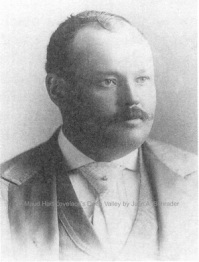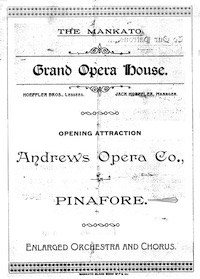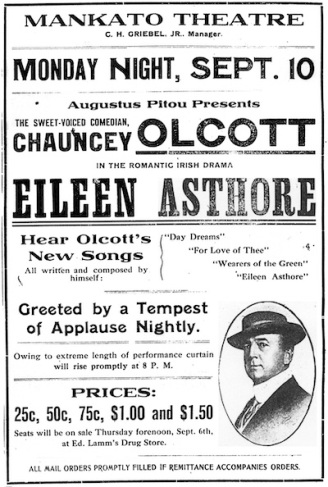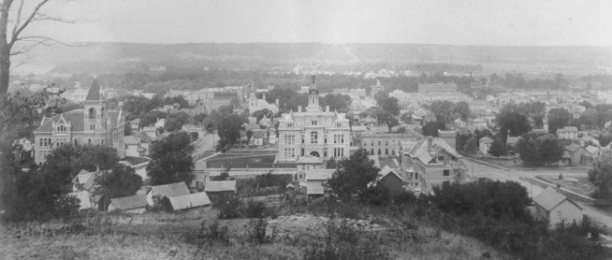
Harmonia Hall, later the Mankato Opera House
Outside, the Opera House was a large brick structure. It was a fine theatre for a town the size of Deep Valley. But Deep Valley was what is known as a good show town. It was a thriving county seat, and theatrical productions, passing from the Twin Cities to Omaha, found it a convenient and profitable one-night-stand.
Winona and Betsy and Tacy and Tib were the first ones inside the house. They did not go at once to their box. First they raced all over the auditorium. It was elegant beyond even Winona’s descriptions and Betsy’s wildest dreams. A giant chandelier hung with glittering crystal drops was suspended from the ceiling. The seats were upholstered in red velvet. The boxes were hung with red velvet tied back with golden cords.
The orchestra started to play. It played sad tunes. Old Kentucky Home, Swanee River, Massa’s in de Cold Cold Ground. All over the house the lights went low. There were rainbow colors in the crystals of the great chandelier as the lights faded away. Then…oh, magic moment!…the curtain started to rise. Slowly, slowly, while the music kept on playing and the rainbow in the chandelier flickered out, forgotten, the curtain lifted. Quote from Betsy and Tacy Go Downtown by Maud Hart Lovelace
Maud’s wonderfully descriptive writing easily transports the reader of the Betsy-Tacy books to the 19th century cultural center of Deep Valley—the Opera House. It’s so easy to imagine what it looked like and how it felt for Betsy and Tacy when they first visited the Opera House.
This is a bit of history about the Opera House that Maud, her family and friends attended in Mankato. I imagine it must have looked just like Maud described it in the books.
Mankato (Deep Valley) owed its Opera House and its status as a regular stop on the theatrical circuits to the enthusiasm for culture of some of its German citizens. William and Jacob Bierbauer purchased land in the 200 block of South Second Street in 1870 and transferred it to the Mankato Harmonia Association, a German singing society. The association completed the building they named Harmonia Hall, in July 1872.
The structure cost $11,000, which was paid by donations and loans. It featured a grand stage, a balcony and a 30-foot ceiling adorned with a dome. The dining area was in the basement and was the same size as the main hall (62 by 70 feet). A grand opening was held on December 25, 1872 with speeches, music and tableaux. The following evening was celebrated with an inaugural ball and dinner.
During its first decade, it was used for performances by local musical and theatrical groups and occasional professional productions. The name was changed to the Mankato Opera House in 1878 when the building was remodeled as a playhouse. The Mankato Review reported “The Boston Ideal Company played Uncle Tom’s Cabin on the night of the 26th to a very large house. The hall was filled, even beyond the over-attendance at the Kellogg concert. Never before have we witnessed such a crowding assemblage” (Jan. 3, 1882)
Just a few weeks later, on January 23, 1882, disaster struck when a fire broke out, which destroyed all but the exterior walls of the building. That evening the temperature was -6 degrees with blowing snow when a policeman discovered the building on fire. Reports alluded to possible arson. Kerosene barrels were stored in the ticket office and had caught fire. Rebuilding began and the structure reopened as a theater, the Mankato Opera House in 1883 and was managed by A.G. Bierbauer (son of William).

Clarence Saulpaugh
Clarence Saulpaugh leased the Opera House in 1893, made extensive improvements and changed the name to Mankato Theatre. Townsfolk seemed to prefer “Opera House”, since this is the name many continued to use. The theater had a seating capacity of 1,000 and was of a horseshoe-type construction, designed so that the stage could be clearly seen from each seat in the house.
The Opera House was the center of both high culture and popular entertainment in Mankato. The early 20th century was the golden age of the theater in America. Opera companies and symphonic bands joined New York-based musical reviews and straight dramatic theatrical companies traveling by railroad from city to city. Everything that came out of New York also came to Mankato because the company would break here when traveling between Minneapolis and Omaha.

Many stage stars, as well as boxers and wrestlers, appeared on the stage at the Opera House. The theatrical programs of the day reveal that almost all of the stage greats appeared at the Mankato Opera House, including Mary Pickford, John L. Sullivan (world-famous boxer), John Drew, Maude Adams, Anna Held, Charles Winnenger, Jos. Jefferson, Gertrude Coughlan, Sousa’s Band, and Mankato’s own Andrews Opera Company. Mankato vocalists also appeared on the theater stage, including Florence MacBeth, who went on to a career in opera and concert, as well as Lora Lulsdorff.
Chauncey Olcott came to Deep Valley in his play, Aileen Asthore. Mr. Ray took the family to hear him. Usually Betsy saw her rare plays at matinees with Winona who had passes because her father was editor of the Deep Valley Sun. But once a year when Chauncey Olcott came, she went to the Opera House in the evening with her parents. The Irish tenor was growing old and stout, but his swagger was as gallant as ever, his voice as honey sweet. Always in the course of the evening the audience made him sing a hit song of earlier years called, “My Wild Irish Rose.” Quote from Heaven to Betsy by Maud Hart Lovelace

Mankato Weekly Review (Sept. 4, 1906)
The Irish tenor Chauncey W. Olcott (1858-1932), was a Mankato favorite. On each of Olcott’s appearances in Mankato special trains were run to the city from towns as far away as Blue Earth and Tracy, Minnesota. Olcott combined the roles of tenor, actor, songwriter and composer in many productions. He is best-known and beloved for his songs; My Wild Irish Rose, When Irish Eyes Are Smiling, and Mother Machree.
The motion pictures spelled the doom of live theatrical entertainment for Mankato and the country as a whole. Several movie theaters opened in Mankato, and by 1921 the Mankato Theater was renamed the Orpheum. It became a second-rate movie house where live performances — usually benefits or school theatricals —were given from time to time, the last of which was given in 1928. That year the building was marked for demolition, but it wasn’t actually taken down until 1931.

Lovely piece with great info. Amazing how even a brief paragraph quoted from “Heaven to Betsy” brings back all of Maud Hart Lovelace’s magic. I think it’s time to re-read them all AGAIN.
It certainly does! Thanks for your comment!
What a wonderful way to start my day. Thanks for the Betsy-Tacy fix.